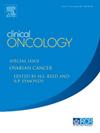Assessing Functional Outcomes and Health-Related Quality of Life After Radiation Therapy in Extremity Soft Tissue Sarcoma
IF 3
3区 医学
Q2 ONCOLOGY
引用次数: 0
Abstract
Aims
Extremity soft-tissue sarcomas (ESTS) are rare neoplasms treated with limb-sparing surgery and radiation therapy (RT). While RT improves local control, it can be associated with late functional impairments that may affect health-related quality of life (HR-QOL). As survivorship care gains importance, understanding the relationship between functional outcomes (FO) and HR-QOL is crucial. This study evaluates the relationship between FO, measured by the Toronto Extremity Salvage Score (TESS), and HR-QOL, assessed with the European Organisation for Research and Treatment of Cancer Quality of Life Questionnaire Core 30 (EORTC QLQ-C30).
Materials and method
A cohort study including ESTS patients treated with RT (January 2009 to October 2024) was conducted. Eligible patients completed the TESS and QLQ-C30 questionnaires. Correlation analyses, receiver operating characteristic (ROC) curve analysis, and statistical comparisons were performed to assess the association between FO and HR-QOL and to determine a clinically relevant TESS threshold for impairment.
Results
Of 255 identified patients, 123 were eligible, and 61 (response rate: 52%) completed the questionnaires. TESS lower-limb scores showed strong correlations with QLQ-C30 physical (r = 0.74), role (r = 0.63), and social functioning (r = 0.62). Notably, ROC analysis identified a clinically meaningful TESS threshold of ≥80, demonstrating high sensitivity (88%) and specificity (100%) for detecting significant functional impairments. Most patients reported good FO and HR-QOL, but a subset experienced severe impairments.
Conclusion
ESTS survivors generally maintain good function and HR-QOL, but functional impairments significantly affect some patients. The identified TESS threshold of ≥80 may help clinicians monitor at-risk patients and guide early interventions. Future studies should validate this threshold and explore interventions for patients with severe impairments.
评估四肢软组织肉瘤放射治疗后的功能结局和健康相关生活质量
目的:四肢软组织肉瘤(ESTS)是一种罕见的肿瘤,可通过保肢手术和放射治疗(RT)进行治疗。虽然RT可以改善局部控制,但它可能与可能影响健康相关生活质量(HR-QOL)的晚期功能障碍相关。随着生存期护理变得越来越重要,了解功能预后(FO)和HR-QOL之间的关系至关重要。本研究评估了用多伦多肢体挽救评分(TESS)测量的FO与用欧洲癌症研究和治疗组织生活质量问卷核心30 (EORTC QLQ-C30)评估的HR-QOL之间的关系。材料与方法对2009年1月~ 2024年10月est患者进行RT治疗的队列研究。符合条件的患者完成TESS和QLQ-C30问卷。通过相关分析、受试者工作特征(ROC)曲线分析和统计学比较来评估FO与HR-QOL之间的相关性,并确定临床相关的苔丝损伤阈值。结果255例患者中,123例符合条件,61例(有效率52%)完成问卷调查。TESS下肢评分与QLQ-C30体质(r = 0.74)、角色(r = 0.63)和社会功能(r = 0.62)有很强的相关性。值得注意的是,ROC分析确定了具有临床意义的TESS阈值≥80,显示出检测显著功能损伤的高灵敏度(88%)和特异性(100%)。大多数患者报告良好的FO和HR-QOL,但一小部分患者出现严重损伤。结论ests存活患者总体上保持良好的功能和HR-QOL,但部分患者功能损害明显。确定的TESS阈值≥80可以帮助临床医生监测高危患者并指导早期干预。未来的研究应该验证这一阈值,并探索对严重损伤患者的干预措施。
本文章由计算机程序翻译,如有差异,请以英文原文为准。
求助全文
约1分钟内获得全文
求助全文
来源期刊

Clinical oncology
医学-肿瘤学
CiteScore
5.20
自引率
8.80%
发文量
332
审稿时长
40 days
期刊介绍:
Clinical Oncology is an International cancer journal covering all aspects of the clinical management of cancer patients, reflecting a multidisciplinary approach to therapy. Papers, editorials and reviews are published on all types of malignant disease embracing, pathology, diagnosis and treatment, including radiotherapy, chemotherapy, surgery, combined modality treatment and palliative care. Research and review papers covering epidemiology, radiobiology, radiation physics, tumour biology, and immunology are also published, together with letters to the editor, case reports and book reviews.
 求助内容:
求助内容: 应助结果提醒方式:
应助结果提醒方式:


